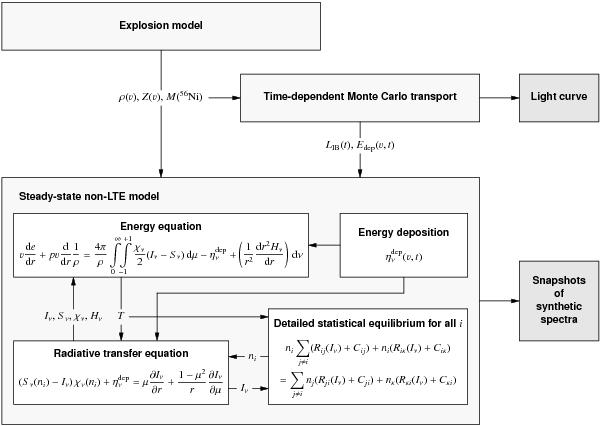Fig. 1

Sketch of our procedure to calculate synthetic spectra and light curves from the
results of SN Ia explosion model calculations. M(56Ni)
is the total mass of 56Ni and Z represents the chemical composition of
the supernova ejecta, which in general has a radial stratification (cf. Sect.
2). In a first step the
time-dependent radiative transfer is solved, determining the energy
deposition rates Edep(v,t) and
the luminosity LIB(t) at the
inner boundary of the non-LTE model along with the light curve.
 is the emission coefficient
resulting from the energy deposition rates (cf. Sect. 3); LIB(t), the
luminosity used for the inner boundary condition of the non-LTE model (cf. Sect.
4), is obtained from the solution of the
time-dependent radiative transfer of the deeper layers. For the outer part
of the ejecta a snapshot calculation for a stationary non-LTE model atmosphere
is performed, using the energy deposition rates and the luminosity from
the time-dependent radiative transfer. As a result this simulation yields the
temperature structure, the occupation numbers along with the ionization structure,
the radiation field, and the synthetic spectrum. The non-LTE model-part shows the
non-linear system of integro-differential equations that form the basis of
stationary atmospheric models, where the detailed statistical equilibrium
determines the occupation numbers ni of the
atomic levels i,j via the collisional (Cij) and
radiative (Rij)
transition rates; the spherical radiative transfer equation yields the radiation
field (χν and
Sν are the
total opacity and source function of all microphysical processes that are
explicitly considered) expressed by the specific intensity Iν, the mean
intensity Jν and the
Eddington flux Hν; and the
microscopic energy equation of matter4 gives
the temperature structure T(r) within the simulated
part of the supernova ejecta (cf. Sect. 4).
r
is the radial coordinate, ρ the mass density, v the velocity,
p
the gas pressure, and e the internal energy; the left-hand side
of the energy equation contains the change of the internal energy and the
adiabatic cooling term, and the right-hand side is the negative of the 0th moment
of the transfer equation describing the total radiation field.
is the emission coefficient
resulting from the energy deposition rates (cf. Sect. 3); LIB(t), the
luminosity used for the inner boundary condition of the non-LTE model (cf. Sect.
4), is obtained from the solution of the
time-dependent radiative transfer of the deeper layers. For the outer part
of the ejecta a snapshot calculation for a stationary non-LTE model atmosphere
is performed, using the energy deposition rates and the luminosity from
the time-dependent radiative transfer. As a result this simulation yields the
temperature structure, the occupation numbers along with the ionization structure,
the radiation field, and the synthetic spectrum. The non-LTE model-part shows the
non-linear system of integro-differential equations that form the basis of
stationary atmospheric models, where the detailed statistical equilibrium
determines the occupation numbers ni of the
atomic levels i,j via the collisional (Cij) and
radiative (Rij)
transition rates; the spherical radiative transfer equation yields the radiation
field (χν and
Sν are the
total opacity and source function of all microphysical processes that are
explicitly considered) expressed by the specific intensity Iν, the mean
intensity Jν and the
Eddington flux Hν; and the
microscopic energy equation of matter4 gives
the temperature structure T(r) within the simulated
part of the supernova ejecta (cf. Sect. 4).
r
is the radial coordinate, ρ the mass density, v the velocity,
p
the gas pressure, and e the internal energy; the left-hand side
of the energy equation contains the change of the internal energy and the
adiabatic cooling term, and the right-hand side is the negative of the 0th moment
of the transfer equation describing the total radiation field.
Current usage metrics show cumulative count of Article Views (full-text article views including HTML views, PDF and ePub downloads, according to the available data) and Abstracts Views on Vision4Press platform.
Data correspond to usage on the plateform after 2015. The current usage metrics is available 48-96 hours after online publication and is updated daily on week days.
Initial download of the metrics may take a while.


